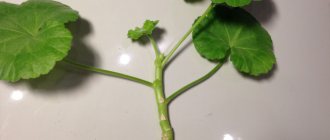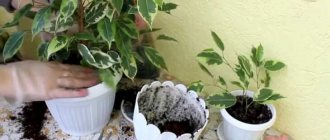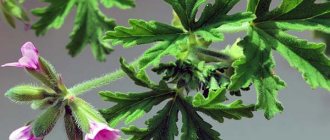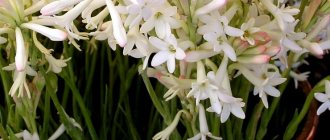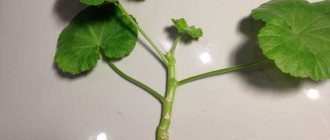For rooting of pelargonium cuttings to be successful, the air temperature must be below 25°C. The right time is the end of winter or the beginning of spring, when the movement of plant juices is activated. It is better to leave the sprouts in partial shade. You can cut geraniums in the fall, but due to the preparation of the flower for hibernation, it will take longer to form roots.
Geranium may not take root in water due to the fact that the cuttings were chosen incorrectly. To prepare viable shoots, follow these recommendations:
- For planting, select cuttings from the apical part of a young flower, from the side shoots.
- Do not water the mother plant before cutting.
- Use a sanitized knife.
- Cut a 5-8 cm piece of stem as close to the bud as possible.
- Remove the lower leaves, peduncles and buds from the shoot.
Pelargonium cuttings
Geranium is propagated in different ways, but often by cuttings, when existing plants are used.
The plant can be rooted in water and soil. Experienced gardeners believe that the process of formation of the geranium root system occurs faster in the soil, but a more viable root is formed in water.
If cuttings are rooted in the ground, you must take into account the requirements:
to cuttings;- to the ground.
How to take cuttings correctly:
- Use only strong and healthy cut shoots.
- The lower leaves are removed.
- Cut cuttings 7-10 cm long.
- Cuttings are made between two leaves.
- At the bottom, the cut should be made below the bud, without leaving the stem, which can rot in water.
- At the top, the cut is made above the bud, without leaving a stem above it, so that the new shoot does not grow to the side and not up.
- The sections must be dried for two hours to form a protective film.
What soil to use:
- The soil should not be very dense. The ideal composition would be: peat (three parts), perlite (one part).
- In addition, rotted compost and pre-calcined soil from the garden should be added to the soil mixture.
As soon as the cuts are dry, you can start planting:
- It is better to put drainage at the bottom of the container.
- Sprinkle soil mixture on top.
- Make a hole in it and place the seedling.
- Compact the earth a little.
- Then water until slightly moist.
After three to four weeks, roots should appear.
More details about how to propagate geraniums by cuttings at home can be found here.
Reproduction of geranium in water - features
For a long time, people have been decorating their homes with plants, especially beautiful and long-flowering ones.
Now many gardeners put a lot of effort and imagination into decorating their garden, using perennial and annual plants, ornamental shrubs and herbs for this. Geranium or pelargonium is loved by many flower growers, gardeners and housewives in all corners of the world. This flower is unpretentious, it is easy to care for, the flowering is abundant and long, and most importantly, it is easily propagated by seeds and cuttings. Today we will look at the propagation of geraniums in water . The plant can be grown indoors and in the garden.
I invite you to the group on Subscribe.ru for summer residents and gardeners: “Country hobbies”
geranium propagation in water
Pelargonium: rooting cuttings in substrate and water
author Koscheeva T., photo by the author
Pelargoniums captivate me with their diversity, unpretentiousness and, of course, beauty!
To replace old pelargonium bushes, young, profusely flowering plants have to be grown regularly. The most common and reliable way to propagate varietal pelargonium is cuttings.
Successful cuttings of pelargoniums depend not only on the skill of the grower, but also on other factors. For example, success depends on the time of year (we have cuttings that take root better in spring and early summer) and on the condition of the plant (cuttings cut from sick pelargoniums that are overfed with fertilizers take root poorly).
We practice two options for rooting pelargonium cuttings - in the substrate and in water.
Pelargonium propagation
Although it is possible to grow a plant from seeds, this process requires some effort and experience from the grower. And in this case it is not always possible to preserve varietal properties. But propagating geraniums by cuttings in water is much easier, if you take into account the characteristics of the plant and the best time for rooting of cuttings.
Propagation by cuttings
This process is simple and can be done by novice flower growers and housewives. Cuttings not only rejuvenate the mother plant, but also allow you to grow young plants by summer, delighting with abundant flowering and decorating your home or garden with lush caps of bright flowers.
Cuttings completely preserve all the characteristics of the variety, leaf and flower color. This property is valuable when propagating a rare, unique variety.
Optimal cutting time
The result of their rooting depends on the time of cuttings. Experts advise carrying it out from mid-February to March 15-20. During the winter, the geranium stretches out due to lack of lighting, becomes ugly and therefore it is necessary to prune the pelargonium.
Of course, you can take cuttings throughout the year, but you should take into account that in winter the survival rate of cuttings is no more than 50%. Geranium takes root well in September, when the bush begins to grow vigorously, but such a young plant will begin to bloom only next year.
How to cut cuttings?
Remember that they can only be cut from a healthy mother plant.
The sequence of work is as follows:
- to cut cuttings you need to take a sharp knife - a blunt knife can damage the stem tissue, which will reduce rooting and slow down the appearance of roots;
- the knife should be disinfected with an alcohol solution;
- the cuttings must have at least 3-5 leaves, the length of the cuttings is up to 5-7 cm for tall varieties and 2.5-4 cm for short ones, the top of the stem is cut off;
- cut the cuttings at right angles to the main stem;
- the buds or flowers on the stem, as well as the lower leaves, are removed to speed up the appearance of roots;
- The cut must be dried in the shade for about 2-3 hours until a film appears on it.
For reliability and quick rooting, sprinkle the cut with any rooting agent (for example, Kornevin) or keep it for the required time in its solution, prepared according to the instructions on the packaging of the drug.
Is it possible to plant like this?
Due to the ability of geranium to survive and continue to grow even in unfavorable conditions, it can be propagated without the use of roots. But in general there are three ways to propagate this crop:
The first method takes too much time and patience, because in order to germinate the seeds, you need to provide strictly defined conditions, the second is quite risky, since the delicate roots are very easy to damage during their division, but the third, by cuttings, is preferred by most people involved in growing and breeding geraniums.
The main advantage of this method is the ability to propagate a plant without disturbing its roots, which guarantees the complete safety of the mother plant.
Rooting cuttings
It can be carried out in two ways: in water or soil mixture.
propagation of geraniums by cuttings in water
Propagation of geraniums by cuttings in water
This method is quite simple and allows you to get good roots if done correctly.
- The water is pre-settled and poured into opaque glasses (or plastic ones).
- Activated carbon tablet powder is added to the water to prevent stem rotting and the appearance of pathogenic microorganisms.
- Only half of the cutting is placed in water, which is changed periodically, preventing it from blooming and evaporating.
- It is better to place the glass in a bright place and shade it.
- When the roots grow to 2.5-3 cm, the plant can be planted in a pot with soil.
Planting in soil mixture
Cuttings with a dried cut can be immediately planted in a separate or common container in the following sequence:
- use a container with a volume of more than 200 ml as a container (a plastic glass will do);
- make a drainage hole in the glass;
- buy special soil or prepare a mixture of peat, perlite and sand in equal proportions;
- any mixture must be poured with a hot pink solution of potassium permanganate;
- first, make a drainage layer of expanded clay or pieces of polystyrene in a glass, then fill the soil mixture to the top and place the cuttings, deepening them by about 4 cm and placing them in the shade for 3-4 days, after which they are placed in a bright place, but without direct sunlight;
Water the plant as the soil dries, but it is better to pour water into the pan.
If the leaf begins to sag or turn yellow, then the seedlings should be placed under a film or jar to create a microclimate.
Caring for young plants
The appearance of new leaves signals the rooting of the young plant. Therefore, now geraniums can be transplanted into another container that is not much larger than the previous one, since geraniums do not require a lot of land. It has been noticed that in a spacious container the plant begins to bloom much later as it first grows a root system to fill the pot. You can plant several plants in a large container.
Further care
You need to specially prepare the cups - make holes in them for water to drain. In addition, thanks to the holes, air penetrates to the roots, which is also very good. Next you need to follow the following instructions:
- Add a little vermiculite to slightly wet, damp soil.
- Fill each cup with soil,
- If the soil was treated with boiling water, you must, of course, wait until it cools down. Fortunately, this will not take much time. Only a few minutes.
- Place the shoots that were previously freed from the lower leaves and deepen them a few centimeters.
- Place the cups on a tray (to make them convenient to move) and place them in a dark place for a while,
- After 5 days, the cups need to be moved to the window. Preferably NOT on the south side.
What to do if yellow, limp leaves appear on some plants? You can place them under the jars. That is, create something like mini-greenhouses for them. Thanks to the special microclimate, the plants will recover in a couple of days.
Propagation of a plant such as geranium is a fairly simple process that anyone who takes it upon can do it. And proper and timely care for a rooted plant will help it delight the eye with its attractive and aesthetic appearance.
Wrong cutting selected
Geranium may not take root in water due to the fact that the cuttings were chosen incorrectly. To prepare viable shoots, follow these recommendations:
- For planting, select cuttings from the apical part of a young flower, from the side shoots.
- Do not water the mother plant before cutting.
- Use a sanitized knife.
- Cut a 5-8 cm piece of stem as close to the bud as possible.
- Remove the lower leaves, peduncles and buds from the shoot.
Pelargonium cuttings
What is a cutting, how to choose and prepare it correctly?
A shoot, or cutting, is a cut part of a plant with one or more nodes.
This cut off part is precisely used for vegetative propagation (by cuttings). In order to get a new geranium, completely identical to the previous one, you first need to select this cutting. When should you take a cutting from the mother flower in order to plant and grow a young plant? The mother plant should be well developed and absolutely healthy, ideally it should be 2 - 3 years old. You need to select the apical cuttings of the mother geranium. This process should be 7–8 cm in length, have one or more nodes (buds, growth points) and 3–5 leaves. If there are leaves left at the base of the cutting, they must be carefully removed.
If the branches of the shoot are the same length as the shoot itself, then you definitely need to cut them off, and then you can use them as independent cuttings. And the finished shoots are left in the air so that the cut areas dry out. If after a few hours they are covered with a thin film, it means that everything went well and the cuttings are ready for the next stage.
Errors during the rooting process
Soaking in water is not used for all varieties of pelargonium. Royal and fragrant must be planted in the ground immediately, otherwise their cuttings will rot. Ivy geranium can be nourished by internal juices for a long time, so roots do not appear. If after 3 weeks the sprout begins to sprout new shoots, rooting will be successful.
Water soaking of shoots is best for geranium zonalis. Leave the liquid for this purpose for 3 days, then add 1 tablet of activated carbon and 1 tbsp. l. Kornevina per 200 ml of water.
Rooted geranium cuttings
To eliminate errors, consider the following nuances:
- Use small containers, such as 200 ml plastic cups. Each should have no more than 1 shoot.
- Pour water to half the volume of the glass, because... The plant needs oxygen to form roots. The liquid should cover only one third of the process.
- Use dark glass containers. Place them in a bright place, but protect them from direct sunlight.
- Do not completely change the water in the cups, but add it as it evaporates, approximately once every 2-3 days.
- Transplant the shoot into a pot after 2-3 weeks, when the roots grow to 3 cm.
Rooting microcuttings in water (on a float and on padding polyester)
I will share my experience in rooting very tiny pelargonium cuttings. After all, it happens that a good cutting from a plant can no longer be cut, but the pelargonium variety needs to be preserved.
If the pelargonium stalk turns out to be just very short, but it has leaves and a small stem, then I fix it on a float with a hole and place it in a glass of water for rooting.
I make a float from the cut off bottom of a plastic cup. I burn a hole in the bottom for installing the handle with a hot nail. And don’t forget to immediately make a cut in the bottom from the edge of the float to the hole! Otherwise, there is a risk of damaging the roots that have grown on the cutting when you remove the rooted cutting from the float for planting.
In the photo: a short stalk of pelargonium with a float has taken root in the water
And if the cutting is very tiny, then I put a piece of padding polyester at the bottom of the glass, pour in a little water, and put the cutting on top. When rooting, the cutting should not touch water - only wet synthetic padding!
The next two photographs show how a tiny pelargonium cutting was placed for rooting in a glass with padding polyester; and he is already with roots.
In the photo: micro-cuttings of pelargonium on padding polyester have taken root in water
In the two bottom photos: micro-cuttings of pelargoniums rooted on padding polyester, which were so tiny that they could not stand in a glass one at a time. Therefore, I set them to root as a group in a wide jar with padding polyester.
In the photo: rooting a group of pelargonium cuttings on synthetic padding in jars of water
Thus, all pelargonium cuttings took root and began to grow. And it turned out to be such a green clearing! However, the rooted cuttings caught their roots on the padding polyester - it was necessary to take them out and plant them earlier.
Tatyana Koshcheeva (Boyarka village, Sverdlovsk region) https://pktn.ru
Weekly Free Digest of the Gardenia.ru Site
Every week, for 10 years, for our 100,000 subscribers, an excellent selection of relevant materials about flowers and gardens, as well as other useful information.
Tips for gardeners on how to root geraniums easily and without problems
Geranium has beautiful flowering and can decorate any windowsill or garden. Of course, you can buy an already mature flowering one for home, but sometimes it’s more interesting to grow a flower yourself. Therefore, many are interested in propagating this plant at home.
To do this, cuttings are most often carried out, because When propagating from seeds, geraniums have to wait a much longer time for flowering.
Diseases and pests
Garden geraniums are usually not susceptible to disease. But sometimes you can notice slight damage with powdery mildew or brown spotting. To prevent the disease from spreading, you need to cut the plant immediately after flowering, after which it will become stronger. The geranium will produce young, healthy leaves that tolerate the cold season well. Large bushes, if they have been damaged by some kind of disease, need to be mowed completely as soon as they bloom. The plant will grow again and bloom a second time.
When affected by brown spot, all shoots are cut off and burned. But it should be noted that garden geranium can become infected with a fungal infection only in cold and rainy summers. The bush will not be seriously affected by this disease.
It is rare, but it happens that the roots are gnawed by the larvae of the sulcata beetle. The plant stops growing. The beetles eat the leaves and their edges dry out. You need to dig up the geranium and check the root. This should be done at night when the beetles are active. If you find larvae, remove them and spray the root and entire plant with a fungicide solution.
Source
How does rooting occur?
Geraniums are propagated in different ways, but often by cuttings, when existing plants are used.
The plant can be rooted in water and soil. Experienced gardeners believe that the process of formation of the geranium root system occurs faster in the soil, but a more viable root is formed in water.
If cuttings are rooted in the ground, you must take into account the requirements:
- to cuttings;
- to the ground.
How to take cuttings correctly:
- Use only strong and healthy cut shoots.
- The lower leaves are removed.
- Cut cuttings 7-10 cm long.
- Cuttings are made between two leaves.
- At the bottom, the cut should be made below the bud, without leaving the stem, which can rot in water.
- At the top, the cut is made above the bud, without leaving a stem above it, so that the new shoot does not grow to the side and not up.
- The sections must be dried for two hours to form a protective film.
How to prepare planting material
To do this you will need a sharp knife. It is advisable that the instrument be disinfected so as not to introduce infection into the wound. This rarely happens, but in some cases a wounded and infected plant may well die.
The selected stem is carefully cut off. Make sure that its length is at least 7-8 centimeters. In addition, it should have 2-3 internodes. You need to cut it at an angle. In this case, the surface of the stem in contact with the soil will be noticeably larger, and accordingly, rooting will occur faster.
When is the best time to do this?
You can experiment at any time of the year. But experienced gardeners believe that geranium takes root faster in the spring.
Summer heat has a negative effect on seedlings , and with high humidity there is a possibility of developing “black leg”.
It is almost impossible to save the affected plant from the “black leg”. The disease develops quickly, the trunk rots from the very root and pruning does not help. When watering, it is better to pour water into the pan to avoid waterlogging of the soil.
If you propagate geranium in the fall, it will have to create greenhouse conditions:
place seedlings under lamps for at least 17 hours a day;- the air should be heated to 23 degrees Celsius;
- In autumn, rooting takes longer, amounting to 35-40 days.
So, for geranium cuttings to take root well, the best period is considered to be from the end of February to May, but your own experience may refute this statement. Rooting is influenced by many factors and each gardener has his own conditions. And yet, in the spring, geranium is always accepted.
Methods
Geranium propagates in several vegetative ways. Breeding by cuttings has one main advantage - the preservation of all maternal qualities. In spring, this happens quite easily and quickly.
Cuttings
Cuttings can be stem, root or leaf.
Root
During the dormant period, the mother plant is carefully dug up and freed from the ground. The above-ground parts are removed so that all the plant’s forces are concentrated on rooting
Then the plant is divided; if necessary, you can use a sharp knife. The cut is treated with a solution of potassium permanganate, and can be sprinkled with charcoal.
Stem
If it is necessary to propagate geraniums using stem cuttings, a part of the stem with two or three buds is used. Typically, annual elongated shoots are used.
A lower horizontal incision is made below the kidney about half a centimeter. The leaves on the prepared cuttings can be cut or removed altogether.
To germinate harvested geraniums, you need to take a loose earthen substrate with a high content of river sand.
Of course, it is necessary to create optimal conditions for germination - high humidity, sufficient light and favorable temperature conditions.
Rooting will be faster if the bowl with the geranium cuttings is placed in a mini-greenhouse - a plastic bag or an inverted glass jar.
As necessary, you need to spray the plantings, opening and ventilating the greenhouse. To successfully plant under the open sky, it is necessary to wait for a stable warm temperature when the threat of return frosts has passed.
Leaf
In order to grow geranium, you can even use a leaf. This method is rarely used, since it has less chance of success, but if all agrotechnical subtleties are observed, it has the right to be used by hardworking gardeners.
It is better to take the leaf used for propagation from a healthy, strong plant from the bottom of the stem. Before planting, the leaf must be saturated with moisture, so it is placed in a glass of water for a week.
A week later, the leaf is placed in an earthen substrate with the stalk down, immersing it with a small part of the plate. The soil is slightly pressed around the planting leaf, sprayed and covered with film. It is necessary to ensure that the edges of the glass or film do not touch the leaf cuttings. The planting container is placed in a warm, dark place. The film cover is regularly removed for ventilation and spraying.
Seeds
Geranium reproduces remarkably well by seeds. This is easy and quick to do, even a beginner can do it. With this method there is still one, but significant, disadvantage. When planting seeds, nature does not guarantee the transfer of maternal qualities, such as variegated leaves or double flower size.
The advantages of propagating geraniums by seeds are several factors.
Let's take a step-by-step look at the process of propagating geraniums by seeds.
It is necessary to pay special attention when purchasing planting material - the seeds must be dense, dry, without inclusions
Disinfection for half an hour in a solution of potassium permanganate and pre-soaking is all that is needed. When planted dry, the seeds will germinate a little later; on average, germination time ranges around 1.5-2 weeks.
After germination of the seedlings, the film is removed.
How to make pelargonium take root in water?
One way to root geranium is to place the cuttings in water and keep them in a warm room for 2-3 weeks.
Instructions:
- place the prepared cuttings in an opaque (since the roots need darkness) container with water;
- use regular water in a 5 cm layer and with the addition of crushed activated carbon;
- The water should be changed every two to three days;
- place the container in a place where there is diffused sunlight, and not direct rays;
- When the shoots take root, they must be transplanted into the ground.
You can find out more about how to grow geranium from seeds at home and care for it after that.
Rooting and caring for geranium shoots
There are two ways to get roots from a shoot. Some gardeners simply place the cuttings in a glass of water and wait for roots to appear. However, excess moisture can cause blackleg disease in geraniums and destroy the shoot. For prevention, you can add a little crushed coal to the water. To speed up the process, it is best to take a dark and opaque container.
As soon as the roots appear, and this can take from 14 to 30 days, the shoot is transplanted into a pot with soil and cared for as an adult flower. However, this rooting method has limitations. For example, royal geraniums may not produce roots for up to 35 - 40 days. During this time, the shoots can either become sick or even begin to rot.
Therefore, rooting is carried out in the ground. A suitable pot is filled with a mixture of universal soil with sand and vermiculite. We must not forget to check for drainage holes in the pot. The day before, the soil is spilled with very hot water and potassium permanganate. Use a stick or pencil to make a hole in the center.
Possible problems and solutions
Sometimes cuttings can remain in water for a long time without forming roots.
Why geranium does not take root in water:
- air temperature above 25 degrees , and this has a bad effect on the development of roots;
- ivy geranium , and this species can be nourished by internal juices for a long time and not take root.
What to do to make roots appear:
- remove the cutting from the water;
- update slice;
- dry overnight;
- In the morning, plant in slightly moist soil.
Methods for growing geraniums from cuttings
Rooting a cutting can be done in two ways, taking into account their advantages and disadvantages.
Rooting geranium cuttings in water
Rooting stem cuttings is quite easy in water. To do this, you need to prepare containers filled with 5 cm of pre-settled water. It is better if the containers are made of dark glass. The cuttings are lowered into the water with the lower cut. The roots appear within a week.
The beauty of this method is that you can observe the rooting process and plant the plant in the ground at the right time. Disadvantage - the edge of the cutting, not having time to release the roots, can rot. To prevent rotting, experienced gardeners recommend adding activated carbon to the water. The water should be changed once every two days.
How to carry out the whole process quickly and without losses?
Sometimes a positive result may not be achieved by following seemingly all the rules. The reason is that the rooting process has its own secrets and subtleties :
In the soil, not only its composition is important, but also its acidity, because... geranium does not like elevated temperatures. Peat is characterized by oxidation, and store-bought soil contains 80% peat.- If during the rooting process all the leaves of the pelargonium have fallen off, there is a possibility that there will be no use anymore, but if only a part has turned yellow and withered, it is possible that it will take root.
- Pots with cuttings can be placed in a greenhouse, for example, under tomatoes - and the light will be diffused and the greenhouse will be ventilated; the lower leaves sometimes turn yellow, but the top will be green and strong.
- Feeding is avoided until the roots grow.
- If the cutting has a flower, it must be removed so that rooting does not slow down.
- Once warmer weather sets in, geraniums should be placed on a balcony or loggia, because... insufficient lighting will lead to loss of decorativeness.
How to plant?
What is required for planting:
- prepare the soil (avoid stagnation of water, add rotted compost and peat);
- make planting holes (deep - designed for a branched root system, with drainage at the bottom);
- plant seedlings , compacting the soil around the plant;
- water abundantly (such watering is allowed only during planting);
- mulch the soil from drying out (spread organic mulch: bark, wood chips, dry peat, compost).
- What do geranium seeds look like in the photo and how to collect them at home?
- Peculiarities of propagation of geranium leaves.
Aftercare
Once geranium is planted in the ground, it, being an unpretentious plant, requires minimal care.
- in watering (when planting you need plenty, and then moderate when the soil is already dry);
- in fertilizing (applying compost and peat during planting is usually sufficient);
- and pruning (for decorative purposes and for preventive purposes, to protect healthy parts of plants from rot).
Experience will help you root geraniums without losing planting material. There is no need to despair if the first result is not what you would like. After all, it depends on the type of geranium, and on the soil, and on the time of planting, and on other conditions. Only experiments will provide the necessary experience.
How to grow geranium from a cutting
To grow geranium from a shoot, geranium cuttings can be cut from a house plant, purchased from hand or at a specialized exhibition. Exchange of cuttings or searching for collectors on the Internet is gaining great popularity among flower growers.
You can cut and root cuttings from any variety of geranium, but hybrid varieties can only be propagated in this way. However, rooting time will vary. The shoot of zonal pelargonium will take root the fastest - in 2 weeks. Royal varieties will give roots in a month. And for fragrant geraniums this process will take up to 1.5 months.
Geranium cuttings are used not only for propagation. From time to time it is recommended to rejuvenate the plant. Several cuttings are cut from it and planted in one or more containers, and the old bush is thrown away. Young geraniums are more decorative, they bloom more profusely and retain all the characteristics of the plant from which they were cut. The plant is usually completely replaced after 3–4 years.
